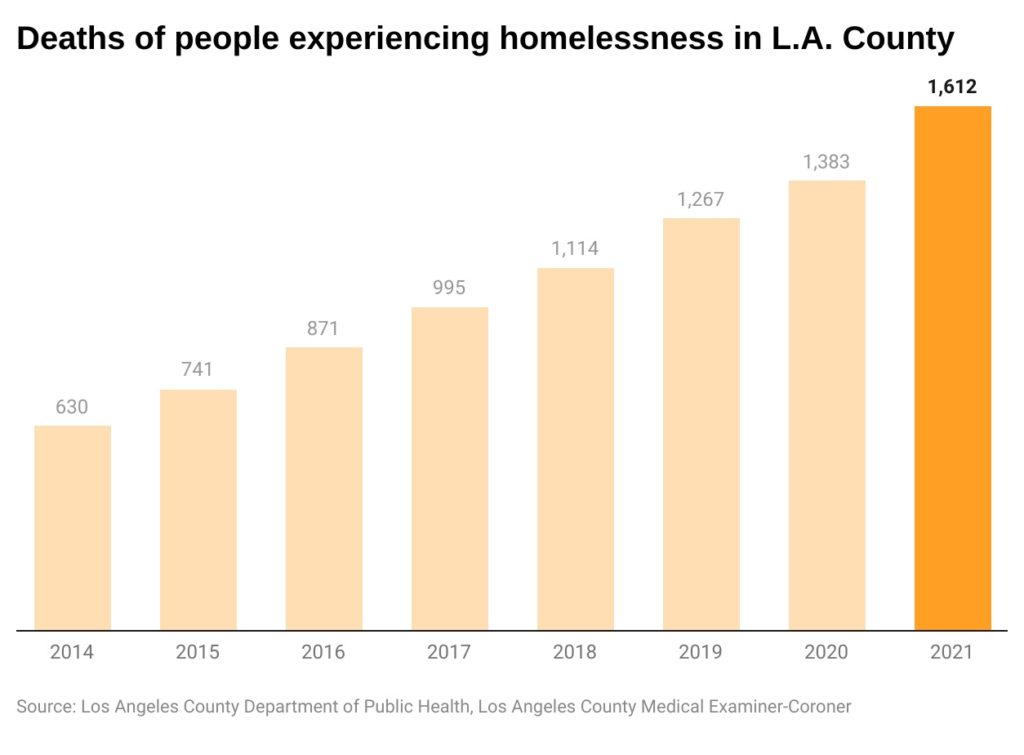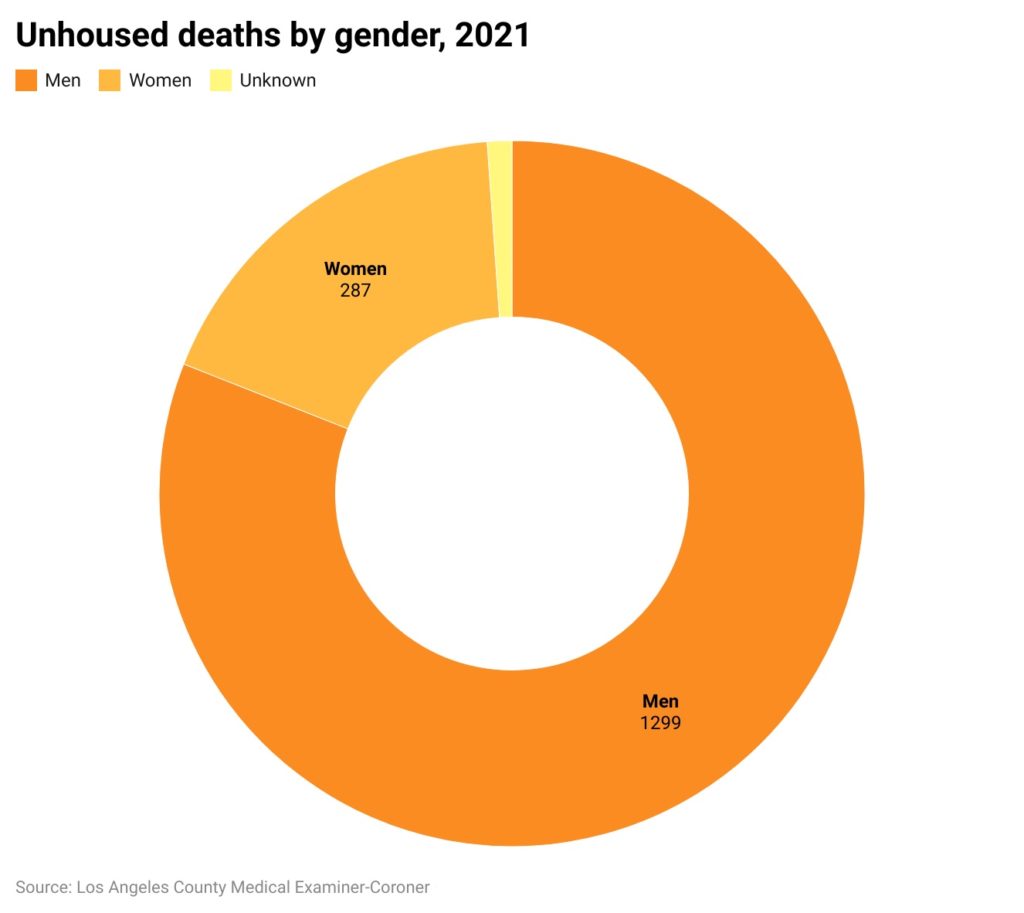More than 1,600 people experiencing homelessness died in Los Angeles last year

In 2020, Los Angeles hit a milestone no one wanted to reach, as 1,383 people experiencing homelessness died. It was the highest figure ever recorded in the region.
Last year, that record was shattered.
A preliminary count from the Los Angeles County Department of Medical Examiner-Coroner’s office found that 1,612 unhoused people passed away in 2021. That is an average of nearly 4.5 people per day, and an increase of 16% from 2020.
Five years ago, 995 unhoused Angelenos died.

Theo Henderson, the creator of the We The Unhoused podcast and an activist-in-residence at the Institute on Inequality and Democracy at the UCLA Luskin School of Public Affairs, thinks the annual numbers are likely an undercount because of how some deaths are tracked by the county.
“The rate of unhoused people that are passing away has been surreal and unreal. It has been demoralizing for the activists. It has been demoralizing for the residents,” he said. “These were people that were in communities, they had loved ones.”
According to a 2020 report from the Los Angeles County Department of Public Health, accidental drug overdoses have been the leading cause of death for people experiencing homelessness. From 2017-2019, unhoused people were 36 times more likely to die of an accidental drug overdose than housed individuals in the county.
The situation was exacerbated in 2020 due to the increasing presence of fentanyl in the drug supply. There was an immediate and alarming increase in fatalities, and from January-July (the period covered in the report), 273 unhoused people died of drug overdoses. That was a 33% increase over the 205 deaths in the same time period in 2019.
[Get COVID-19, crime and other stats about where you live with the Crosstown Neighborhood Newsletter]
The second leading cause of death for unhoused people in that time period was heart disease, which the Department of Public Health attributes to the growing number of elderly people without a permanent home.
People experiencing homelessness have also been susceptible to the ravages of the coronavirus pandemic. The Department of Public Health reported that as of Feb. 6, nearly 300 unhoused county residents had died of COVID-19.
The 2020 Greater Los Angeles Homeless Count identified 66,436 people living without permanent shelter across Los Angeles County, including tens of thousands of individuals residing in tents, makeshift dwellings and vehicles. The next homeless count, organized by the Los Angeles Homeless Services Authority, is scheduled for the end of this month (the 2021 count was canceled due to the pandemic).
The U.S. Department of Housing and Urban Development recently released its 2021 Annual Homeless Assessment Report. It found that on any given night last year, in addition to those on the streets, more than 326,000 people experiencing homelessness stayed in some sort of shelter facility. That is a decrease of 8% from 2020.
‘We’re dying so young’
In 2020, life expectancy in the United States was 77 years, according to the Centers for Disease Control and Prevention. A report from researchers at UCLA, in conjunction with a coalition of people experiencing homelessness in Los Angeles, found that the average age of unhoused individuals who died in the region between March 2020 and July 2021 was 47.
A number of elements can put unhoused Angelenos at risk of illness or early death. Exposure to winter cold and rain, as well as summer heat waves, can have severe health impacts. So can a lack of clean water and no or limited restrooms and hygiene facilities. Some people are at risk due to untreated mental illness.
Ruth, an unhoused woman staying in the San Fernando Valley who asked that her last name not be used, thinks about this reality often.
“It’s the average age that’s really bad and it keeps getting lower. No one notices that we’re dying so young,” she said.
Ruth has been unhoused since she was 13. She is now in her 30s, and said the number of people she knows who have died in the past year has been difficult to comprehend. On New Year’s Eve alone, she said, two people who lived near her passed away.
“People don’t notice when we die or go missing,” she said.
Andy Bales, the president and chief executive of Union Rescue Mission on Skid Row in Downtown, has long decried the situation on the streets, and has been adamant that authorities need to push for more short-term shelters and temporary housing, rather than relying primarily on building permanent supportive housing units that can cost more than $500,000 per unit. He is one of many who has advocated for treating homelessness like a natural disaster.
“We are losing our most precious resource—people,” he said. “To have it go from 900 deaths just a few years ago to 1,612 is just heart-wrenching, and it doesn’t have to happen.”
There have long been more men than women living on the streets in Los Angeles, and that is reflected in the number of deaths. According to the Coroner’s office, 1,299 unhoused men died last year, compared with 287 unhoused women (gender was not available in 26 deaths).

Despite all the attention on addressing homelessness in Los Angeles, including plans from people running for mayor, the situation is hardly improving. This January, 162 people experiencing homelessness died, according to the Medical Examiner-Coroner. That is only slightly down from January 2021, when 172 deaths were reported.
How we did it: We examined data from the Los Angeles County Medical Examiner-Coroner and the Los Angeles County Department of Public Health.
Investigators at the Medical Examiner-Coroner’s office categorize a decedent as homeless depending on where their body was found or if they do not have an established residence. Data from the Medical Examiner-Coroner includes only deaths under their jurisdiction. Some figures may change once a final year-end report is completed. Specific information on certain categories was only available through Feb. 2.
Interested in our data or have additional questions? Email us at askus@xtown.la.






